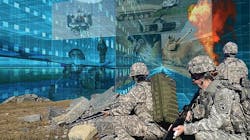Aerospace and defense electronics industry optimistic on adaptability to technological, political changes
NASHUA, N.H. – The evolution of aerospace and defense electronics technologies accelerates at a staggering pace, yet readers of Military & Aerospace Electronics overwhelmingly are optimistic in their abilities to adapt to future changes in technologies, military priorities, and Washington politics.
A year-end survey of Military & Aerospace Electronics readers finds that more than eight in ten feel extremely, very, or somewhat optimistic of their company's ability to adapt successfully to future technological and political changes amid shifting military priorities.
The survey reveals that 39.2 percent of readers are very optimistic about their abilities to adapt to changes, 26.5 are somewhat optimistic, and 18.6 are extremely optimistic, while 15.7 percent are slightly or not at all optimistic.
Related: Technology and politics of the new U.S. Space Force
The survey, conducted in October and November, polled Military & Aerospace Electronics readers on eight core questions: most important aerospace and defense electronics applications; most important military programs; most important enabling technologies; company future health; needs from electronics vendors; top business threats; and ability to adapt to change.
The most important applications among Military & Aerospace Electronics readers are command, control, reconnaissance, and surveillance; unmanned vehicles; secure networking and communications; artificial intelligence and machine learning; and trusted computing and cyber security.
Also of interest, although not to the degree of the top-five applications, are electronic warfare (EW); high-performance embedded computing and digital signal processing; 5G communications for military operations; hypersonic weapons and aircraft; and directed-energy technologies like laser weapons and high-power microwaves.
Rounding out the top-15 applications among readers are strategic and tactical missile defense; new military helicopter programs; advanced manned fighter and bomber aircraft; countermine warfare; and revitalization of the nation's nuclear arsenal.
Related: The role of technology in securing the nation’s borders
Readers identified their top-18 military programs of importance to their companies. The top-six programs are the GPS III secure navigation satellite; F-35 joint strike fighters; Terminal High Altitude Area Defense (THAAD); Large Unmanned Surface Vehicle (LUSV); space-based overhead persistent infrared surveillance; and Joint Light Tactical Vehicle (JLTV).
Other programs of interest are the future B-21 long-range strike bomber; Virginia-class fast attack submarines; next-generation land-based intercontinental ballistic missile (ICBM), or Ground-Based Strategic Deterrent (GBSD); P-8A Poseidon maritime patrol and surveillance aircraft; F-15EX air-superiority jet fighters; and the FFG(X) future Navy frigate.
Rounding out the top-18 most important military programs to Military & Aerospace Electronics readers are the armored multi-purpose vehicle; SM-3 Aegis ballistic missile defense weapons; Arleigh Burke-class Flight III destroyers; U.S. Marine Corps CH-53K heavy-lift helicopters; Long-Range Anti-Ship Missile (LRASM); and Columbia-class ballistic missile submarine.
At the top of the most important enabling technologies for Military & Aerospace electronics readers are sensors; embedded computing and digital signal processing; software applications and real-time software; electro-optics; trusted computing and cyber security; and RF and microwave components.
Related: The technological challenges of developing reliable, deployable hypersonic weapons
Rounding out the most important enabling technologies are test and measurement equipment; cabling, connectors, and interconnect technologies; power control and conditioning; radiation-hardened electronic components; and data buses and networking.
What do Military & Aerospace Electronics readers need most from their vendors? Readers answered technology development and innovation; continued support and supply of legacy components; software development and support; trusted computing and cyber security support; manufacturing support; and obsolescence management.
Asked about the importance of annual increases to the U.S. defense budget, 82 percent said budget increases are extremely, very, or somewhat important to their companies. Fewer than 18 percent said annual defense budget increases are slightly or not at all important.
What about company health and growth potential over the next 18 months? Nearly 18 percent said their company prospects are extremely, very, or somewhat strong. Less than 12 percent said their company prospects are slightly or not at all strong, and 3 percent are undecided.
So what keeps Military & Aerospace Electronics up at night? Political changes in Washington; a potential downturn in the U.S. economy; trade wars with China; revolutionary changes in technology; Brexit or other EU-related issues; and regional conflicts in areas like the Middle East.
Other potential worries are political gridlock in Washington; a future financial crisis; and a downturn in U.S. military spending.
About the Author
John Keller
Editor-in-Chief
John Keller is the Editor-in-Chief, Military & Aerospace Electronics Magazine--provides extensive coverage and analysis of enabling electronics and optoelectronic technologies in military, space and commercial aviation applications. John has been a member of the Military & Aerospace Electronics staff since 1989 and chief editor since 1995.
